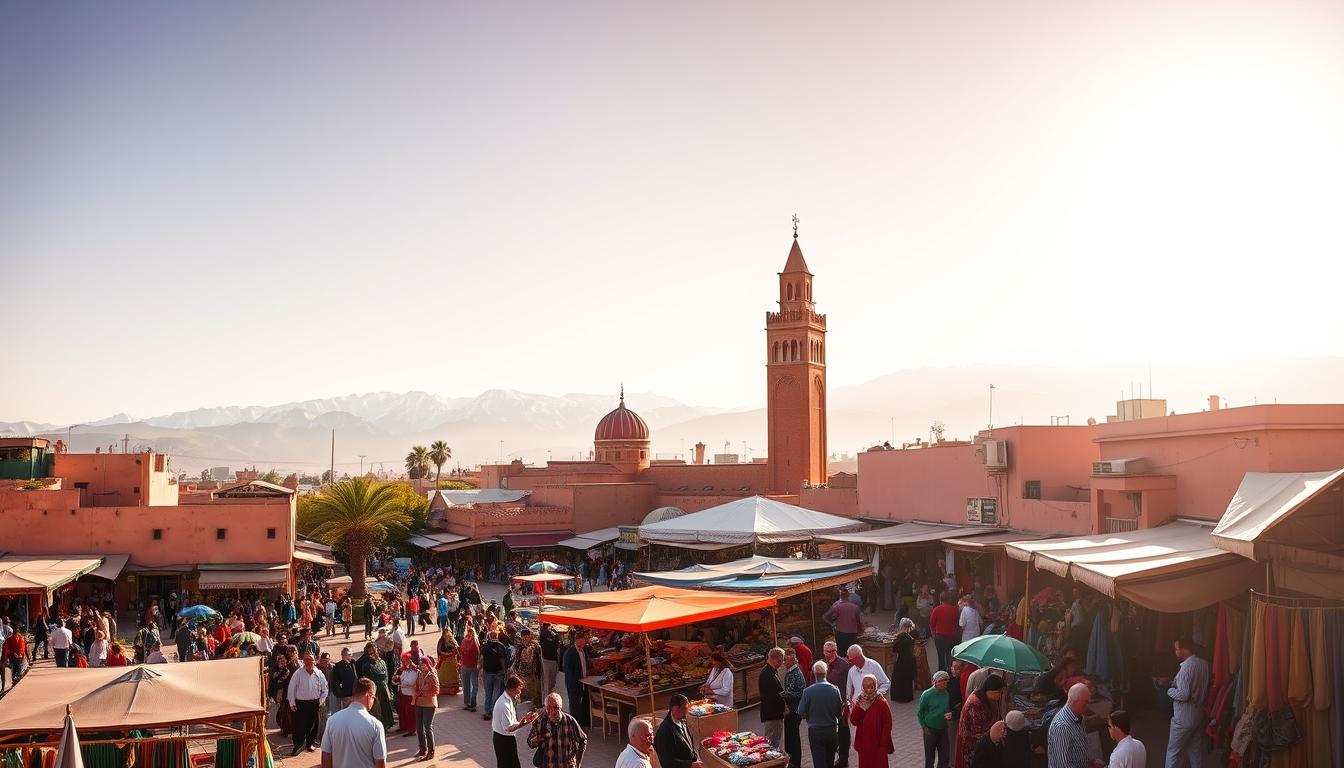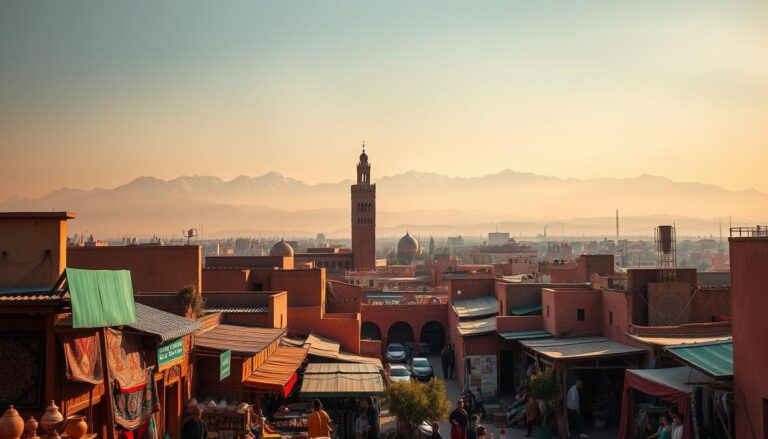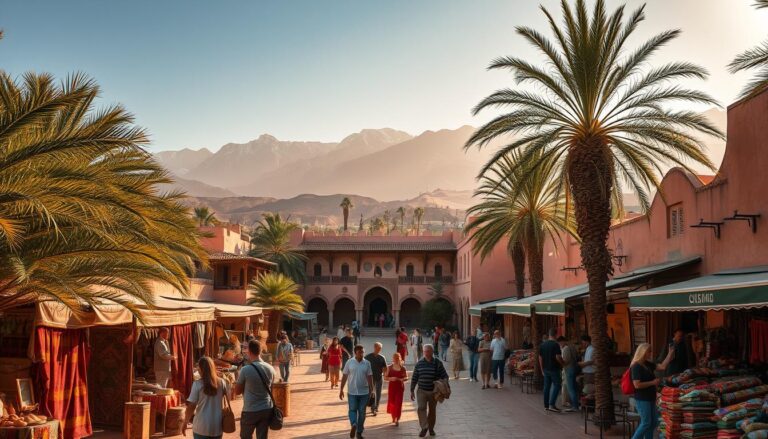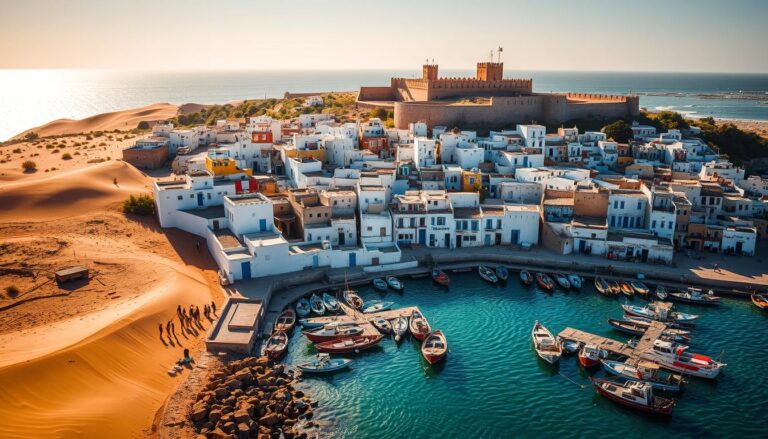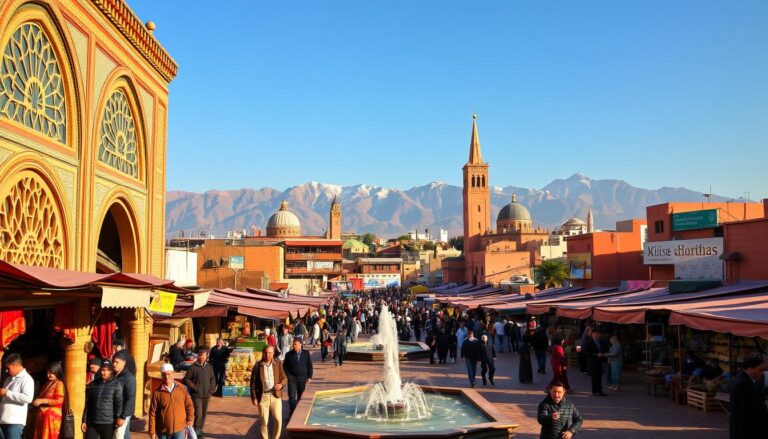Morocco Travel Itinerary & Tips: What to Know Before You Go
Table of Contents
Did you know 78% of UK travellers underestimate this North African gem’s size by nearly 40%? Spanning over 710,000 km² – larger than France and Germany combined – its landscapes shift from snow-dusted peaks to sun-baked dunes within a single day’s drive. One globetrotter aptly called it their “twenty-first country and fourth continent”, hinting at the sheer variety packed into its borders.
What keeps drawing adventurers back? It’s the way ancient medinas hum with life beside trendy cafés, or how a sunset over the Sahara feels like stepping into a golden postcard. Regular visitors often describe it as their “escape that sparks joy” – a place where every corner serves up surprises, from handwoven textiles in Marrakech’s souks to starlit Berber camps in the desert.
Planning matters here. The country’s diversity means you could be sipping mint tea in Fes’s ninth-century quarter one morning and hiking through Atlas Mountain villages the next. Yet with smart preparation, you’ll uncover why seasoned explorers return year after year, finding fresh magic in every visit.
Key Takeaways
- Over three-quarters of visitors misjudge the country’s vast scale, requiring thoughtful route planning
- Landscapes range from Mediterranean coasts to dramatic desert expanses within relatively short distances
- Cultural experiences blend centuries-old traditions with contemporary creative energy
- Many repeat travellers cite the welcoming local hospitality as a key reason for return visits
- Strategic timing allows you to experience both lively urban centres and tranquil natural retreats
Introduction: Your Ultimate Guide to Morocco
What transforms a first-time visit into a lifelong love affair? It’s that moment when bustling souks feel less chaotic and more like a vibrant dance – a rhythm you learn to embrace. Regular visitors often describe their journey as “more than a holiday”, with each return unveiling fresh layers of cultural richness.
Smart planning lets you balance lively explorations with peaceful moments. Mornings might involve navigating colourful markets, while afternoons could see you sipping sweet mint tea in a shaded courtyard. This contrast defines the country’s charm – energetic yet restorative.
Timing shapes your experience profoundly. Consider these seasonal insights:
| Season | Experience | Our Tip |
|---|---|---|
| Spring | Mild temperatures nationwide | Perfect for mountain treks |
| Summer | Coastal breezes vs desert heat | Focus on Essaouira or Chefchaouen |
| Autumn | Harvest festivals in valleys | Join olive picking experiences |
| Winter | Snow in Atlas, sun in Sahara | Pack layers for temperature swings |
Many travellers find themselves drawn back annually, each visit deepening their connection. “You don’t just see Morocco – you feel it,” shares a London-based tour leader. Preparation matters: comfortable shoes for medina wanderings, lightweight scarves for sun protection, and an open mind for spontaneous discoveries.
Approach local customs with curiosity rather than hesitation. A simple “shukran” (thank you) opens doors, while observing prayer times shows respect. This mindful approach helps you experience the country’s rhythm rather than fighting against it.
Exploring Marrakech’s Medina and Souks
Marrakech’s medina pulses with energy, its narrow lanes offering endless discoveries. Locals often advise visitors to “lose the map for an hour” – it’s the best way to stumble upon hidden courtyards or artisan workshops. While the maze seems daunting, you’ll find it easier to navigate than other historic quarters, especially with offline Google Maps guiding your stroll.
Navigating the Labyrinthine Medina
Let curiosity guide your steps. The medina’s layout reveals itself through subtle clues – arched doorways with distinctive carvings or spice-scented alleys leading to communal bakeries. A seasoned traveller shares: “When you stop trying to ‘win’ the maze, you start seeing its rhythm.” Save energy for the souks by wearing comfortable shoes and carrying water.
Bartering Tips in the Bustling Souks
Negotiation here is both sport and social ritual. Vendors expect haggling – start at 10% of the initial price and settle around 30%. If they won’t budge, smile and walk away. You’ll often get called back with better offers. For quality things, head to Souk Semmarine. Look for these markers of craftsmanship:
| Item | Quality Signs | Fair Price Range* |
|---|---|---|
| Leather Goods | Even stitching, subtle dye | £15-£40 |
| Ceramics | Hand-painted details | £8-£25 |
| Textiles | Dense weave, natural dyes | £20-£60 |
*Prices vary based on size and complexity
Remember, a lot of stalls sell similar items. Take time to compare before committing. As one shopkeeper wisely notes: “The best deals happen when both sides feel they’ve won.”
Where to Stay in Marrakech: Traditional Riads and Modern Hotels
Step into a world where time slows and every detail whispers stories of craftsmanship. Your choice of accommodation becomes part of the adventure, blending heritage with contemporary comforts.
Experiencing the Charm of a Riad
These traditional houses-turned-guesthouses offer something chain hotels can’t replicate. At Riad Ksar Al Amal, staff anticipate needs before you ask – think early check-ins and pre-dawn breakfasts for desert excursions. Nightly mint tea by the courtyard firepit creates lasting memories.
The architecture itself enchants. Central courtyards feature zellige tile mosaics and citrus trees framing plunge pools. “You don’t just sleep here – you live part of Marrakech’s soul,” remarks a recent guest at Riad Jardin Secret. Most places include breakfasts of msemen pancakes and freshly squeezed orange juice.
Staying within the medina walls puts you moments from vibrant souks, yet cocooned in tranquillity. Rooftop terraces offer sunset views over terracotta rooftops, while hidden lounges provide cool retreats. It’s the perfect place to recharge after exploring colourful alleyways.
For those prioritising location and character, riads deliver unparalleled immersion. Their intimate scale fosters connections – with staff, other travellers, and the city’s rich artistic legacy. You’ll find these places become more than accommodation; they shape your entire experience.
Essential Sights in Marrakech
Marrakech’s architectural wonders offer more than Instagram backdrops—they’re portals to bygone eras. Two standouts reveal contrasting facets of the city’s heritage through intricate design and clever planning.
Timing Your Palace Visit Perfectly
Arrive at Bahia Palace by 3pm to experience its grandeur without midday crowds. This gives you two hours to wander through 150 rooms adorned with cedarwood ceilings and zellige tilework. “The orange tree courtyard alone justifies the entry fee,” shares a recent visitor. Golden light filters through citrus branches in late afternoon, creating prime photo opportunities.
Museum Strategy for Savvy Explorers
Dar El Bacha Museum rewards early birds. Put your name down at its café immediately—the 90-minute wait becomes valuable exploration time. Use the interval to study rare Berber jewellery displays and Andalusian-inspired archways. When your table’s ready, black-tied waiters serve silver trays of pastries amidst palm-frond screens worthy of a Bogart film.
| Attraction | Best Time | Pro Tip |
|---|---|---|
| Bahia Palace | 3pm-5pm | Follow sun patterns for optimal photography |
| Dar El Bacha | Morning slots | Combine café reservation with exhibit tours |
This one-two punch lets you master Marrakech’s cultural heartbeat in a single day. Allow three hours total—you’ll leave with both iconic memories and hidden gems few travellers discover.
Delightful Moroccan Mint Tea Experiences
Ever noticed how mint leaves whisper against glass when tea pours? This refreshing ritual surprises visitors – even sworn coffee devotees find themselves reaching for third cups. Locals call it “Berber whisky”, though its magic lies in sweetened gunpowder green tea and fresh spearmint sprigs.
Rooftop Teas and Evening Rituals
Head upwards for the best mint tea experiences. Terrasse des Epices serves steaming silver pots alongside honey-drenched pastries, with Atlas Mountain breezes cooling your porcelain cup. Waiters demonstrate the traditional high pour – liquid arcs creating frothy bubbles said to “awaken the tea’s spirit”.
As dusk falls, seek out firelit courtyards where tea-making becomes theatre. Crackling logs harmonise with the glug-glug of poured liquid, while steam carries whispers of desert herbs. “It’s not just a drink – it’s a conversation starter,” shares a Marrakech riad owner. Staff often share stories between refills, turning simple breaks into cultural exchanges.
Three elements define authentic preparation:
- Fresh mint bruised (not crushed) to release oils
- Tea brewed strong then sweetened with chunky sugar
- Three pours between pot and cup to aerate
You’ll find these rituals create unexpected pauses in your day – moments to savour saffron sunsets or watch swallows dart between rooftop antennas. By trip’s end, that first hesitant sip becomes a cherished daily rhythm.
Unique Cultural Encounters in Moroccan Cities
What separates mere sightseeing from transformative journeys? It’s leaning over a clay oven as a grandmother demonstrates kneading techniques unchanged since her childhood. These human connections turn postcard moments into lived experience.
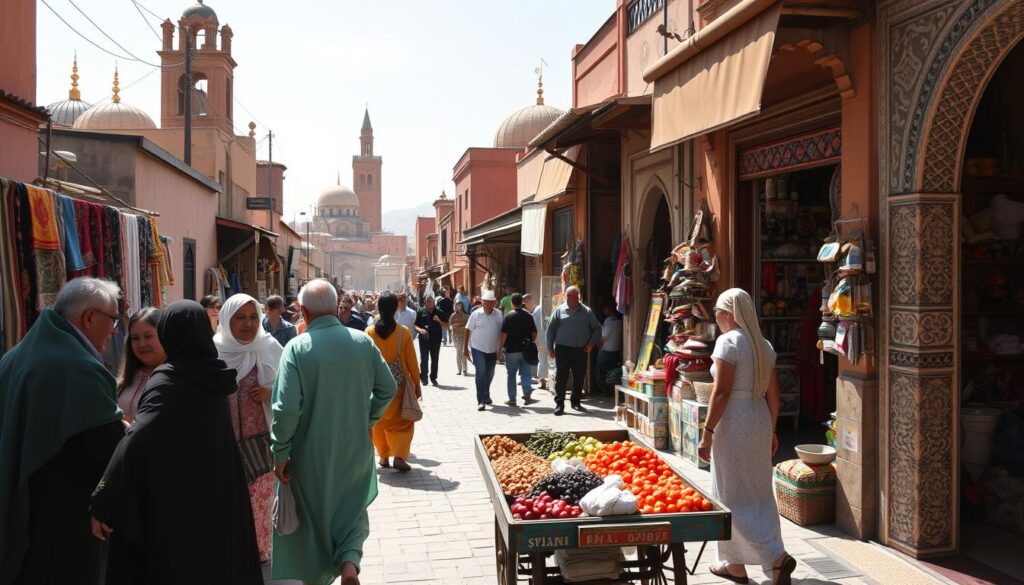
Where Craftsmanship Meets Daily Living
At Beldi Country Club’s workshops, glassblowers shape molten silica into intricate lamps using methods perfected through generations. “Watching their hands work felt like seeing alchemy,” recalls a Bristol traveller. Similar magic unfolds in mountain villages where women bake khobz bread in communal clay ovens – you’ll taste warmth beyond mere temperature.
Urban explorations reveal quieter rhythms too. Follow locals through city backstreets to discover hole-in-the-wall cafés serving msemen pancakes at dawn. In Fes, tanneries buzz with activity as workers dye leather using medieval-era pits. These glimpses into daily life showcase resilience meeting modernity.
Berber hospitality transforms strangers into guests. Share couscous steamed over aromatic wood fires while learning phrases in Tamazight. A shopkeeper in Marrakech’s medina advises: “Ask about their craft’s history – you’ll see eyes light up.” Such exchanges remind us that people shape places more than monuments.
Respectful curiosity unlocks deeper connections. When photographing artisans, always seek permission. Learn basic greetings – a simple “sbah l-khir” (good morning) bridges gaps. These mindful touches transform standard tours into shared human experience, creating memories that outlast any souvenir.
Crafting Your Perfect Morocco Travel Itinerary
Finding your rhythm here means blending discovery with downtime. A four-day Marrakech blueprint lets you taste both heritage and modern comforts without rushing. Start gently – your first afternoon settles you into a riad’s shaded courtyard before visiting Bahia Palace as crowds thin.
Balancing Timeless Traditions and Contemporary Culture
Day two dawns with souk exploration. Move clockwise through the medina’s alleys to spot leatherworkers and spice stalls. Post-lunch, visit landmarks like El Badi Palace when sunlight gilds its ruins. As one guide advises: “Follow the cats – they know the coolest spots in summer.”
Day three mixes learning with leisure. Arrive early at Ibn Youssef School to admire carved cedar ceilings undisturbed. Secure a café reservation at Dar El Bacha before browsing exhibits – their rose-infused pastries justify the wait. Evenings suit rooftop mint tea with Atlas Mountain views.
| Day | Focus | Pro Tip |
|---|---|---|
| 1 | Orientation & Palace | Unpack before exploring |
| 2 | Markets & Landmarks | Clockwise medina route |
| 3 | History & Downtime | Book café in advance |
| 4 | Wellbeing & Leisure | Hammam before noon |
Your final day prioritises rejuvenation. Riads with plunge pools offer serene escapes from midday heat. Try a guided hammam tour – the 10am slot avoids post-lunch queues. Leave afternoons free for last-minute finds in the medina.
This approach lets you savour each experience rather than ticking boxes. As a Marrakech resident notes: “The best trips have gaps – that’s where magic sneaks in.” Build buffer time between activities, and let scents of orange blossom guide spontaneous detours.
Indispensable Tips for First-Time Visitors
Ever felt overwhelmed by a maze of colourful stalls? Start with a local guide for your first souk visit – they’ll help you spot quality things and decode bargaining customs. As one Fes resident puts it: “Our alleys tell stories, but you need someone to teach you the language.” After gaining confidence, venture solo using downloaded offline maps.
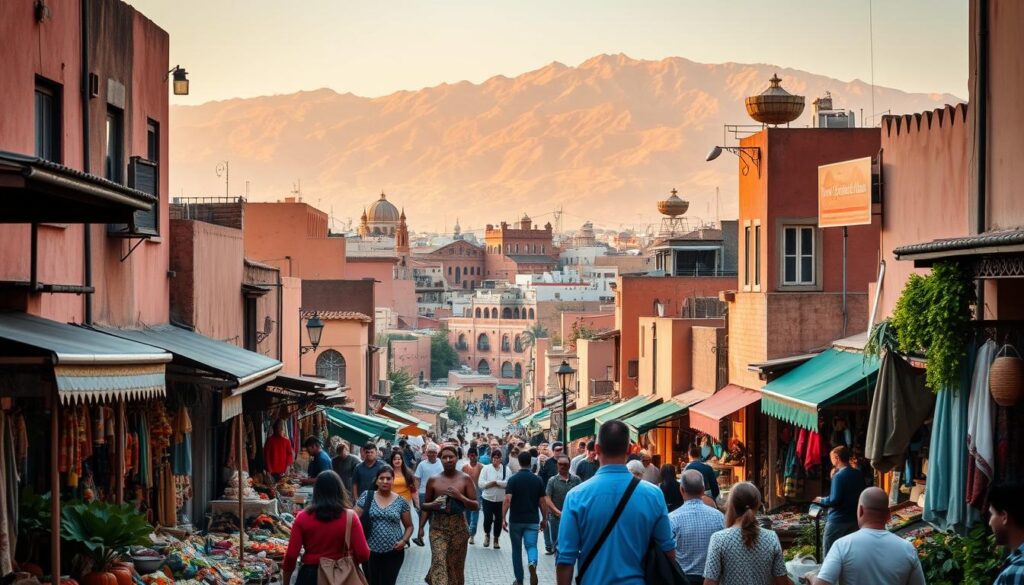
Don’t fear wrong turns. Getting lost reveals hidden cafés where people share mint tea and directions. Locals often chuckle at confused explorers, then graciously point the way. Save energy for vendors’ banter – a firm “non, merci” works better than ignoring them.
Three things transform culture shock into delight:
- Try street food at busy stalls (long queues mean fresh ingredients)
- Follow intriguing side streets – they often lead to peaceful courtyards
- Pause during call to prayer – let the haunting melodies reset your pace
Smartphones help, but old-school tactics work too. Note distinctive door knockers or tile patterns as landmarks. A Marrakech shopkeeper advises: “The best way to explore? Let your nose guide you – follow the scent of fresh bread or cedarwood carvings.”
Lastly, pack patience. What feels chaotic at first becomes a thrilling dance of sights and sounds. As you master the rhythm, you’ll find the people here want you to love their home as much as they do – even if their sales tactics suggest otherwise!
Best Time and Duration for Your Morocco Trip
Timing your adventure requires balancing golden sunshine with practical preparation. March to May and September to November gift you with warm days for exploring medinas, while evenings cool enough for stargazing from riad rooftops. These seasons let you pack light layers rather than wrestling with extreme temperatures.
When Nature Plays by Its Own Rules
Even the Sahara surprises seasoned travellers. Imagine arriving during a rare rainstorm after drought years, desert thermometers stubbornly reading 12°C instead of the promised 20°C. Locals shrug – their homeland thrives on delightful unpredictability. Summer visits work if you embrace morning explorations and post-lunch poolside recovery.
Three essentials for any trip duration:
• Allow extra days for weather adjustments
• Schedule key activities in cooler morning hours
• Pack versatile layers – mountain passes chill quickly
While infrastructure handles heat better than cold, a compact umbrella proves handy year-round. As one guide chuckles: “Our sunshine’s generous – it just occasionally overdelivers.” With smart timing, you’ll find every season reveals unique charms.

